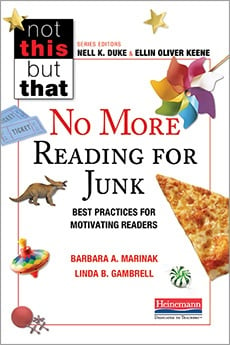
In the newest book from the "Not This But That" series, No More Reading For Junk, coauthors Barbara A. Marinak and Linda B. Gambrell want a classroom where reading is its own reward, instead of reading being a means to accrue junk prizes like pizza or spinning tops or raffle tickets or, in this excerpt from the book, a chance to put the school's principal on the roof for an entire day. While entertaining, these prizes are short-lived and distracting from the real goal: creating confident and empowered readers who stay motivated for life.
By Linda B. Gambrell
In the town of Pageville, the Principal of Hobbit Elementary School places a high value on reading and wanted to motivate the students to spend more time reading. In September, he called all the students into the assembly room and announced a reading challenge: “If Pageville Elementary students read 1,000 books before the end of the school year I will spend an entire day on the roof of the school.” The three hundred K–6 students at Pageville were up to the challenge! Students read, teachers recorded the books completed, and, sure enough, on May 1, the principal spent the day on the roof, sitting in his favorite chair that had also been hoisted to the roof!
—
The major concern is whether this results in any long-term impact on students' motivation to read.
—
While Pageville is an imaginary town, this story is not. The “principal on the roof” is an incentive that many schools have used, in one variation or another, in an effort to increase students’ motivation to read. In this book we take a careful and thoughtful look at the research base for practices that promote motivation to read and those that do not. While there are no studies that suggest that the “principal on the roof” results in increased motivation to read, it probably does encourage some students to spend time reading. The major concern, however, is whether this practice results in any long-term impact on students’ motivation to read and, in particular, does it increase reading motivation for those students who struggle with literacy learning. Activities such as “principal on the roof” bring to the forefront the issue of whether there is educational value in using incentives and rewards to promote reading motivation.
Let’s examine the “principal on the roof” event in light of what research tells us about motivating students to read. Studies indicate that the “principal on the roof” will most likely not be effective in nurturing students’ motivation to read for several reasons. First, the reward of seeing the principal sitting on the roof is too far removed (by weeks and perhaps months) from the actual act of reading. Research indicates that when rewarding a behavior in an attempt to foster motivation, the presentation of the reward must be immediate. Students value the reward less the longer they have to wait. In addition, it is important to note that even if the reward of the principal sitting on the roof were more immediate, due to the extrinsic nature of the incentive, the effects would be short lived (Fryer et al. 2012).
In addition, incentives such as the “principal on the roof” do not nurture motivation because they are not closely related, or proximal, to the desired behavior (reading). Having a principal engage in a humorous act like sitting on the roof, while entertaining and perhaps temporarily interesting, is not directly related to the desired behavior of reading. In other words, if students who are not motivated to read participate in this activity, their reading engagement is most likely to be temporary and only for the purpose of seeing the principal on the roof—not because they have become more motivated to read (Marinak and Gambrell 2008).
No More Reading For Junk: Best Practices For Motivating Readers is out now. Click here to learn more.
♦ ♦ ♦ ♦
Barbara A. Marinak, Ph.D., is a Professor and Chair of the Education Department at Mount St. Mary's University where she teaches literacy and research courses.
Linda B. Gambrell is Distinguished Professor of Education at Clemson University. She is past president of the International Reading Association.



